Semia is a genus of Asian cicadas in the tribe Cicadini, erected by Matsumura in 1917.
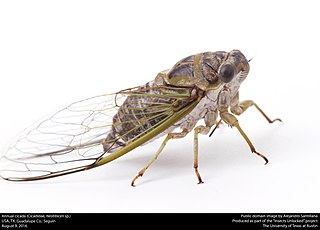
Cicadidae, the true cicadas, is the largest family of cicadas, with more than 3,200 species worldwide. The oldest known definitive fossils are from the Paleocene, a nymph from the Cretaceous Burmese amber has been attributed to the family, but could also belong to the Tettigarctidae.

Pomponia is a genus of cicadas from Asia. A group of species previously placed in Pomponia, containing the largest cicada species found on earth, have recently been moved to Megapomponia. However, the remaining species still form a very heterogeneous group and Duffels and Hayashi (2006) mentioned that several species should probably be transferred to genera like Terpnosia and Leptosemia.
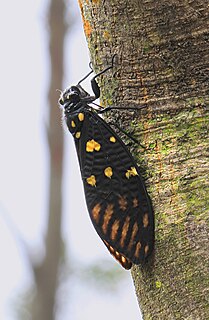
Gaeanini is a tribe of cicadas in the family Cicadidae, found in the Palearctic and Indomalaya. There are about 10 genera and at least 50 described species in Gaeanini.
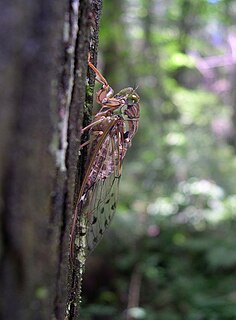
Tanna is a genus of cicadas from Southeast Asia and East Asia. In 2010 Lee and Hill placed Tanna in the subtribe Leptopsaltriina, which is now in the tribe Leptopsaltriini together with a number of related genera that also possess abdominal tubercles, including Leptopsaltria, Maua, Nabalua, Purana, and others.
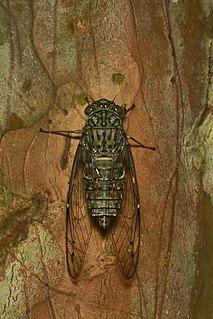
Purana is a genus of cicadas from Southeast Asia. Its distribution includes Java, Sumatra, Borneo, the Philippines, peninsular Malaysia, Thailand, India, Indochina, China, and Japan. Only one species has been recorded east of the Wallace Line, Purana celebensis, from Sulawesi. In all species the male possess two pairs of dark ventral abdominal tubercles on third and fourth sternites. The male opercula are rather short and generally do not reach beyond the posterior pair of tubercles. Related genera that also possess abdominal tubercles are Leptopsaltria, Maua, Nabalua and Tanna which together with Purana are in the subtribe Leptopsaltriina of the tribe Leptopsaltriini.

Formotosena is a genus of cicadas from Southeast Asia erected by Kato in 1925 to accommodate the species Formotosena seebohmi which was previously placed in the genus Tosena. Members of Formotosena are found in Southeast Asia, including southern China, Hainan and Taiwan.

Maua is a genus of cicadas from Southeast Asia. The males possess two pairs of dark ventral abdominal tubercles on third and fourth sternites.

Cryptotympana is a genus of cicadas from Southeast Asia.
Pacarina is a genus of cicadas in the family Cicadidae. There are at least four described species in Pacarina.

Cacama is a genus of cactus dodgers in the family Cicadidae. There are about 12 described species in Cacama.
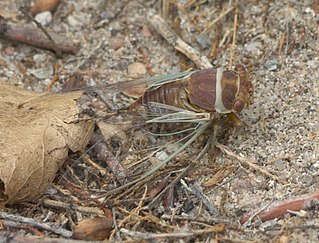
Diceroprocta is a genus of scrub cicadas in the family Cicadidae. There are at least 60 described species in Diceroprocta.
Abroma is a genus of cicadas in the family Cicadidae. There are at least 20 described species in Abroma.
Calcagninus is a genus of cicadas in the family Cicadidae. There are at least three described species in Calcagninus.

Champaka is a genus of cicadas in the family Cicadidae. There are about 12 described species in Champaka.
Malagasia is a genus of cicadas in the family Cicadidae. There are at least three described species in Malagasia.
Ollanta is a genus of cicadas in the family Cicadidae. There are at least four described species in Ollanta.
Orapa is a genus of cicadas in the family Cicadidae, found in tropical Africa. About five described species are in Orapa. Orapa is the only genus of the tribe Orapini.
Burbunga is a genus of cicadas in the family Cicadidae, found in Australia. There are about 11 described species in Burbunga.
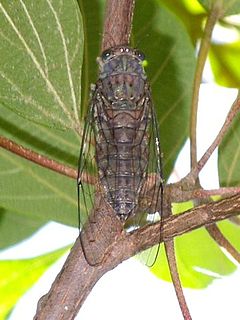
Leptopsaltriini is a tribe of cicadas in the family Cicadidae. There are at least 200 described species in Leptopsaltriini, found in the Palearctic, Nearctic, and Indomalaya.












